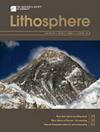胶东半岛中生代岩浆岩套的岩石成因:壳幔相互作用和去岩浆化的意义
IF 1.7
4区 地球科学
Q3 GEOCHEMISTRY & GEOPHYSICS
引用次数: 2
摘要
华北克拉通古生代岩石圈较厚(>200 km),中生代岩石圈逐渐去中心化。然而,下地壳深处地幔的实际过程仍不清楚。中生代花岗质岩石可为研究北华北盆地去岩浆化机制提供重要线索。在此,我们进行了微量元素模拟,以验证太古宙下地壳的部分熔融是否可以产生这些中生代岩浆套。同时进行了锆石Hf同位素分析,揭示了壳幔相互作用过程,并进一步对北陆块体去碳化化给出了约束条件。玲珑、郭家岭、爱山套、郭家岭套基性微颗粒包体(MMEs)和基性岩脉的锆石Hf同位素数据差异较小,玲珑(160 ~ 150 Ma)、郭家岭(~130 Ma)和爱山(118 ~ 116 Ma)套的锆石εHft分别为-25.4 ~ -14.5、-15.3 ~ -10.4和-23.1 ~ -11.9。白垩系基性岩墙(126 Ma)的εHft值为-22.8 ~ -17.7。郭家岭花岗闪长岩(DCW-2A, 129 Ma)的锆石εHft= -13.0 ~ -8.9。郭家岭花岗闪长岩及其MMEs的闪孔组成计算的温度-压力条件基本相同,暗示可能存在岩浆混合作用。我们的模拟结果表明,某些微量元素(如Tb, Yb和Y)必须保留在源中以匹配玲珑套件的组成,这需要侏罗纪中大量的石榴石残留物(高压熔融)。早白垩世石榴石为主的下地壳富集Yb / y,但缺乏Sr和La等元素。因此不可能形成类似郭家岭套的高Sr/Y、La/Yb等地球化学特征。综合模拟结果和锆石Hf同位素数据,我们认为NCC东部地壳在侏罗纪(灵珑花岗岩)发生了增厚和部分脱水熔融,形成了含有大量石榴石(重量大于50%)的榴辉岩残余物,而早白垩世软流圈地幔热含水基性岩浆上涌引起下地壳和岩石圈地幔的熔解。在此期间,胶东岩石圈地幔和部分下地壳被对流地幔移走。大约10万年后,当爱山套形成时,地壳不再厚,在中等压力下发生熔融,这并不一定需要丰富的石榴石作为残留相。本文章由计算机程序翻译,如有差异,请以英文原文为准。
Petrogenesis of Mesozoic Magmatic Suites in the Jiaodong Peninsula: Implications for Crust-Mantle Interactions and Decratonization
The North China Craton (NCC) has thick lithosphere in the Paleozoic (>200 km) but appears to be decratonized in the Mesozoic. However, the actual processes operated in the lower crust-deep mantle are still unclear. The Mesozoic granitic rocks can provide important clues to the NCC decratonization mechanism. Here, we conducted trace element modeling to check whether partial melting of the Archean lower crust can generate these Mesozoic magmatic suites. Meanwhile, zircon Hf isotope analysis was conducted to reveal crust-mantle interaction processes and further give constraints on the decratonization of the NCC. Zircon Hf isotope data of the Linglong, Guojialing, and Aishan suites, the mafic microgranular enclaves (MMEs) in the Guojialing suite, and mafic dykes display minor differences: the Linglong (160–150 Ma), Guojialing (~130 Ma), and Aishan (118–116 Ma) suites have zircon εHft=–25.4 to –14.5, –15.3 to –10.4, and –23.1 to –11.9, respectively. The Cretaceous mafic dyke (126 Ma) has a highly negative εHft value (–22.8 to –17.7). Meanwhile, the MMEs (in the Guojialing granodiorite, DCW-2A, 129 Ma) have zircon εHft=–13.0 to –8.9. Temperature-pressure conditions calculated using amphibole compositions for both the Guojialing granodiorite and its MMEs are basically identical, implying possible magma mixing. Our modeling results show that certain trace elements (e.g., Tb, Yb, and Y) have to be retained in the source to match the composition of the Linglong suite, which requires substantial garnet residues (high-pressure melting) in the Jurassic. The Early Cretaceous garnet-dominated lower crust is Yb-/Y-enriched but depleted in elements like Sr and La. Therefore, it could not form geochemical features like high Sr/Y and La/Yb ratios akin to the Guojialing suite. Integrating the modeling results and zircon Hf isotope data, we propose that the crust in the eastern NCC had thickened and partially melted by dehydration to produce an eclogitic residue containing a large amount of garnet (>50% by weight) during the Jurassic (Linglong granite), whereas upwelling of hot and hydrous mafic magma from the asthenospheric mantle induced fluxed melting of both the lower crust and lithospheric mantle in the Early Cretaceous, during which the lithospheric mantle and part of the lower crust in the Jiaodong were removed by the convective mantle. About 10 Mys later while the Aishan suite formed, the crust was not thick anymore, and melting occurred under moderate pressure which does not necessarily require abundant garnet as the residue phase.
求助全文
通过发布文献求助,成功后即可免费获取论文全文。
去求助
来源期刊

Lithosphere
GEOCHEMISTRY & GEOPHYSICS-GEOLOGY
CiteScore
3.80
自引率
16.70%
发文量
284
审稿时长
>12 weeks
期刊介绍:
The open access journal will have an expanded scope covering research in all areas of earth, planetary, and environmental sciences, providing a unique publishing choice for authors in the geoscience community.
 求助内容:
求助内容: 应助结果提醒方式:
应助结果提醒方式:


